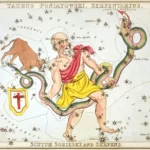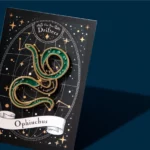Ophiuchus Through the Ages: a Comprehensive Look at its Historical Significance
Have you ever heard of Ophiuchus? It is a constellation that often gets overlooked due to the popularity of the traditional zodiac signs. However, Ophiuchus has a rich and fascinating history that dates back centuries. In this article, we will delve into the early origins of Ophiuchus, its role in astrology throughout the ages, and its recent resurgence in popular culture. We will also explore the controversies surrounding Ophiuchus and uncover its true astronomical significance. So, join us on this captivating journey through time as we uncover the hidden secrets of Ophiuchus and its historical significance.
Contents
- The Early Origins of Ophiuchus
- Ophiuchus in Astrology
- Ophiuchus in Medieval Astrology
- Ophiuchus Rediscovered: Modern Interpretations
- Unveiling the Astronomical Ophiuchus
- Conclusion
- Frequently Asked Questions
- References
-
Frequently Asked Questions
- Can you explain the origins of the Ophiuchus constellation?
- How is Ophiuchus connected to astrology?
- What are some historical interpretations of Ophiuchus?
- How did Arabic astrology influence the perception of Ophiuchus?
- What is the significance of Ophiuchus in medieval astrology?
- How has Ophiuchus been depicted in popular culture?
- What are some controversies surrounding Ophiuchus?
- What can we learn from the astronomical perspective of Ophiuchus?
- How does Ophiuchus feature in stellar cartography?
- What does the alignment with the Ophiuchus constellation signify?
- References
- Read More
The Early Origins of Ophiuchus
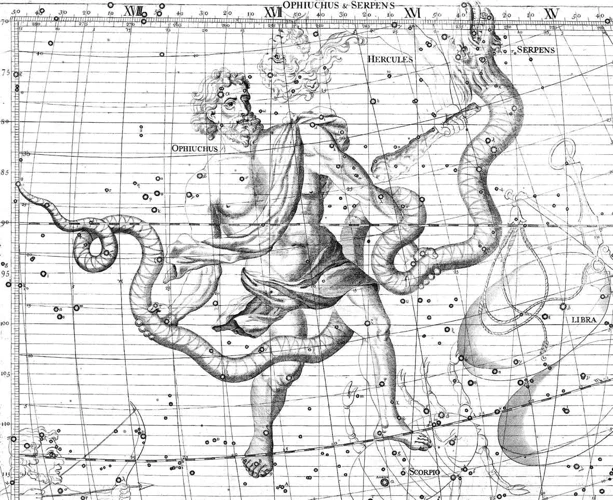
The early origins of Ophiuchus can be traced back to its mythological roots. In Greek mythology, Ophiuchus is associated with Asclepius, the ancient god of medicine and healing. Legend has it that Asclepius was a mortal who possessed extraordinary healing abilities. His knowledge of herbs and medicine was so powerful that he could even bring the dead back to life. Asclepius became revered as a god and was often depicted holding a serpent-entwined staff, the symbol of modern medicine that we still use today. This representation of Ophiuchus ties in with its astrological symbol, a serpent or snake. The significance of the serpent lies in its association with rebirth and rejuvenation. Ophiuchus’ connection with healing and the medical profession continues to be celebrated in contemporary times. This celestial figure’s influence extends far beyond ancient Greece, as Ophiuchus also appears in the mythology of other ancient civilizations.
|
|
These diverse cultural representations of Ophiuchus exemplify its global significance in ancient history. Across civilizations, this constellation’s association with healing, wisdom, and creation is a consistent theme. The stories and beliefs associated with Ophiuchus continue to intrigue and inspire people today, as we explore the profound influence of this celestial figure on astrology, spirituality, and human personality.
The Mythological Roots
The mythological roots of Ophiuchus delve deeper into its association with the ancient Greek god Asclepius and the serpent symbolism. Asclepius, also known as Aesculapius in Roman mythology, was renowned for his extraordinary healing abilities and was often depicted holding a staff with a serpent wrapped around it, known as the Rod of Asclepius. The inclusion of the serpent in the symbol is believed to represent rejuvenation and rebirth, as serpents shed their skin and emerge renewed. This connection between healing and serpents dates back to ancient times, as snakes were observed shedding their skin and humans associated this phenomenon with the restoration of health and vitality.
The story of Asclepius further emphasizes his healing prowess. It is said that Asclepius learned the art of medicine from the centaur Chiron and became so skilled that he could resurrect the dead. This ability angered Hades, the god of the underworld, who complained to Zeus about the imbalance it caused in the cycle of life and death. In response, Zeus struck Asclepius with a thunderbolt, killing him. However, recognizing Asclepius’ contributions to humanity, Zeus placed him among the stars as the constellation Ophiuchus.
Throughout different mythologies, serpents have been regarded as symbols of wisdom, healing, and transformation. The association of Ophiuchus with the serpent reflects the belief in the healing properties of the constellation and its celestial power. The mythological roots of Ophiuchus provide a glimpse into the ancient world’s understanding of the constellation and its connection to the realm of medicine and spiritual healing.
Ophiuchus in Astrology
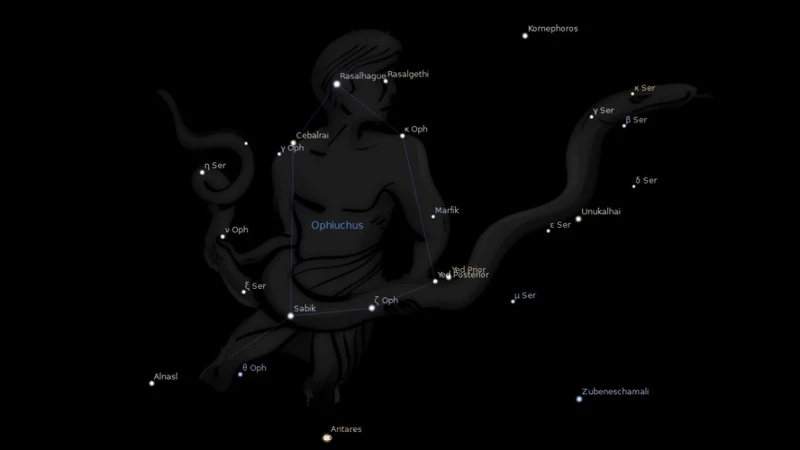
Ophiuchus has a unique place in astrology, often regarded as the “13th zodiac sign” that exists outside the traditional twelve. This constellation’s alignment with the sun during certain periods of the year has led to debates and discussions about its influence on astrological interpretations.
Ophiuchus is said to encompass the dates between November 29 and December 17, overlapping with parts of Scorpio and Sagittarius. Due to its positioning within the ecliptic, Ophiuchus has been associated with a distinct set of personality traits and characteristics. People born under this sign are believed to possess qualities such as intuition, wisdom, and a deep connection to the spiritual realm.
Throughout history, interpretations of Ophiuchus in astrology have been varied. In ancient times, it was seen as a symbol of healing and transformation. Astrologers regarded those born under Ophiuchus as natural healers and observers with an ability to bring balance and harmony to those around them. Ophiuchus was considered a powerful and enigmatic sign, associated with profound insights and transformative experiences.
|
|
|
Ophiuchus in Medieval Astrology
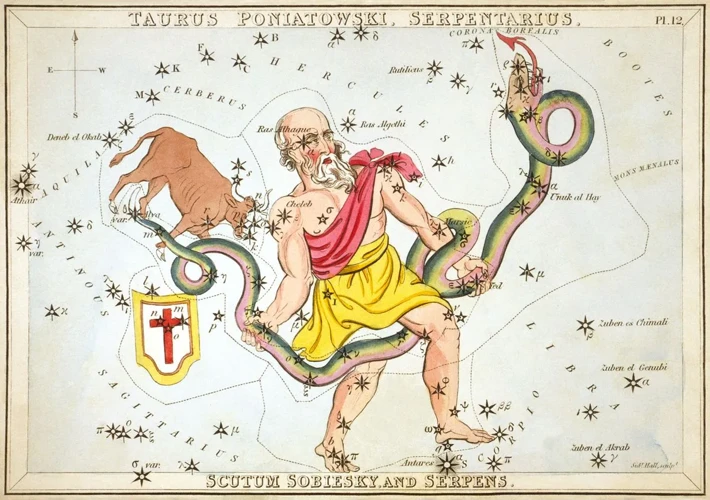
Ophiuchus in medieval astrology held a unique place among the celestial figures of the time. During this period, astrology played a significant role in people’s lives, and Ophiuchus was recognized as the thirteenth zodiac sign. Medieval astrologers believed that the celestial alignment of Ophiuchus influenced an individual’s personality traits and destiny. They associated this constellation with attributes such as wisdom, healing, and transformation. Ophiuchus was considered to be a powerful sign, possessing deep knowledge and a natural affinity for the mystical arts. However, its inclusion in the zodiac was short-lived, as the current twelve zodiac signs gained more prominence over time. Despite its limited presence in medieval astrology, Ophiuchus remained a symbol of cosmic power and wisdom. In art and illustrations of this era, Ophiuchus was often depicted as a figure holding a serpent and a staff, representing the celestial healer. The influence of Arabic astrology during the medieval period contributed to the persistence of Ophiuchus as an influential figure in astrological practices.
Medieval astrologers and scholars associated Ophiuchus with mystical and spiritual qualities, exploring its connection to the divine and invoking its symbolism in their teachings. The influence of Ophiuchus on astrology during this era gave rise to various interpretations and theories that shaped beliefs and predictions. Despite its later omission from the traditional zodiac system, the legacy of Ophiuchus in medieval astrology remains a fascinating chapter in the evolution of astrological practices. Gaining a deeper understanding of Ophiuchus in the context of medieval astrology allows us to appreciate the intricate tapestry of beliefs and interpretations that have shaped our understanding of this enigmatic constellation.
The Influence of Arabic Astrology
Arabic astrology played a significant role in shaping the understanding and interpretation of Ophiuchus. During the Islamic Golden Age, Arab astronomers and astrologers made substantial advancements in the field, incorporating their own cultural beliefs and practices into the existing astrological traditions. Ophiuchus, known as “Al Hawwa” in Arabic, became a prominent figure within Arabic astrology. Arab scholars recognized the healing symbolism associated with Ophiuchus, representing it as a skilled physician carrying a staff with a serpent coiled around it.
|
|
Arabic astrologers recognized the transformative power of Ophiuchus, considering it to mark a significant shift in an individual’s astrological profile. Those born under the influence of Ophiuchus were believed to possess unique qualities that set them apart from others. These characteristics included an enhanced ability to heal, a strong intuition, and a natural inclination towards spiritual pursuits. Ophiuchus holds a prominent place in Arabic astrology, signifying the importance of this celestial archetype in shaping astrological interpretations and providing individuals with deeper insights into their personalities and life paths.
Note: For an artistic interpretation of Ophiuchus, you can refer to the image linked here: Unveiling Ophiuchus by Artists.
Ophiuchus and the Renaissance Period
During the Renaissance period, Ophiuchus played a significant role in the development of astrology and the exploration of celestial knowledge. This era, known for its revival of intellectual and artistic pursuits, saw a renewed interest in the stars and the mysteries of the universe. Ophiuchus found its place in the astrological practices of the time, highlighting the interplay between science, spirituality, and astrology.
The Renaissance scholars delved into ancient texts, including those from Greek and Arabic sources, to uncover hidden wisdom and expand their understanding of astrology. They sought to refine astrological knowledge by incorporating Ophiuchus into the zodiac system, acknowledging its unique position in the celestial sphere. This inclusion meant that there were now thirteen zodiac signs instead of the traditional twelve.
Artists of the Renaissance period also found inspiration in Ophiuchus. Paintings and sculptures often depicted the zodiac, and artists like Leonardo da Vinci and Michelangelo were known to incorporate celestial motifs into their works. These artists’ fascination with Ophiuchus reflects their connection to the broader cultural interest in exploring the mysteries of the universe.
During this period, Ophiuchus became associated with elements of healing, philosophy, and alchemy, further emphasizing its connection to the medical and spiritual realms. Renaissance astrologers believed that Ophiuchus’s presence in a birth chart could indicate exceptional healing abilities, wisdom, and a deep connection to spiritual matters. The alignment of Ophiuchus with these qualities provided individuals with a broader understanding of their cosmic identity and potential.
The Renaissance period marked a renaissance, a “rebirth,” of knowledge and discovery, and Ophiuchus played a role in expanding the existing astrological framework. As scholars and artists explored the depths of astrology, Ophiuchus contributed to a more nuanced understanding of the cosmos and humanity’s place within it.
Ophiuchus Rediscovered: Modern Interpretations
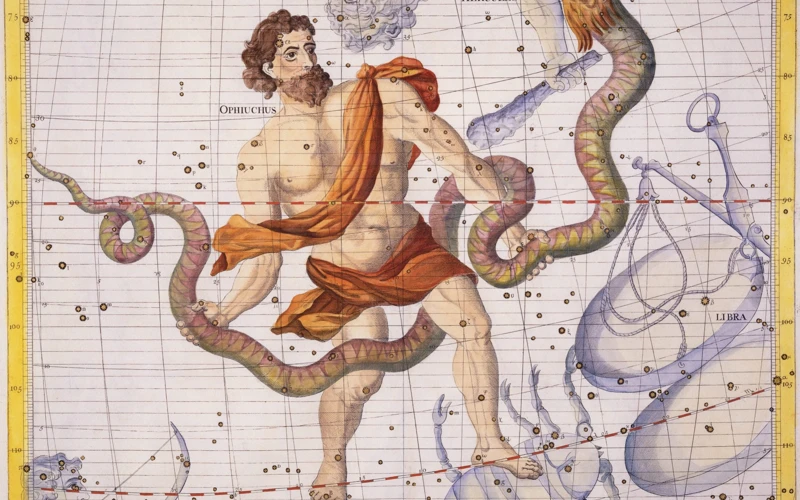
Ophiuchus has experienced a resurgence in modern interpretations, particularly in the realm of astrology. While the traditional zodiac signs have been widely recognized for centuries, Ophiuchus has gained attention as the “13th sign” of the zodiac. This concept arose from the discrepancy between the astrological signs and the actual positions of the constellations in the sky. The rediscovery of Ophiuchus sparked debates and controversies among astrologers and enthusiasts worldwide.
Ophiuchus in Popular Culture: Ophiuchus has made its way into popular culture, appearing in various forms of media and artistic expressions. Artists have been captivated by the mystique and symbolism surrounding Ophiuchus, leading to stunning visual interpretations of this celestial figure. (To see some artistic depictions of Ophiuchus, click here.) From paintings and sculptures to jewelry and tattoos, Ophiuchus continues to inspire creative individuals who seek to showcase its beauty and significance.
Controversies and Debates Surrounding Ophiuchus: The inclusion of Ophiuchus as a 13th zodiac sign has remained a topic of discussion and controversy. Some astrologers argue that Ophiuchus should be recognized as a valid sign due to its alignment with the ecliptic (the apparent path of the Sun in the sky). However, others contest this notion, adhering to the traditional 12-sign zodiac system. This controversy has led to a wider exploration and reevaluation of astrological practices. If Ophiuchus were to be included, it would necessitate a reconfiguration of birth charts and astrological interpretations, potentially altering individuals’ understandings of their personalities and life paths.
Amidst these controversies, Ophiuchus has also gained attention for its alleged unique personality traits. It is claimed that individuals born under the sign of Ophiuchus possess distinctive spiritual qualities and talents. (To gain a deeper understanding of the spiritual aspects of Ophiuchus personalities, click here.) These individuals are often described as intuitive, compassionate, and possessors of great wisdom. Many believe that embracing the energy of Ophiuchus can lead to personal growth, spiritual transformation, and a deeper connection with the cosmos.
The modern interpretations of Ophiuchus have propelled it into the spotlight, igniting further exploration of its astrological and spiritual significance. Whether as a source of artistic inspiration or a subject of intense debate, Ophiuchus continues to captivate and fascinate individuals seeking to uncover its hidden mysteries and unlock its full potential.
Ophiuchus in Popular Culture
Ophiuchus, though often overlooked in mainstream astrology, has left a mark on popular culture in various forms. From literature to music, this enigmatic constellation has captured the imagination of artists and creators. One notable example is the novel “The Serpent’s Shadow” by Rick Riordan, part of the popular “Percy Jackson & The Olympians” series. In this book, Ophiuchus plays a significant role as a character representing healing and the restoration of balance.
|
|
|
These references in popular culture help bring awareness to Ophiuchus and its unique characteristics. They showcase its association with healing, wisdom, and the pursuit of balance. While Ophiuchus may still be overshadowed by the traditional zodiac signs, its presence in art and entertainment serves as a reminder of the constellation’s historical significance and its ongoing impact on human imagination and creativity.
Controversies and Debates Surrounding Ophiuchus
Controversies and debates surrounding Ophiuchus have arisen primarily due to its inclusion as a thirteenth zodiac sign. This addition challenges the traditional twelve zodiac signs that have been widely accepted for centuries. The debate centers around whether Ophiuchus should be considered a legitimate zodiac sign and how its inclusion may affect the existing astrological system.
Shift in Zodiac Dates: One of the main reasons for the controversy is the potential shift in zodiac dates. The addition of Ophiuchus would require redistributing the astrological calendar, resulting in new date ranges for each sign. This shift has sparked discussions among astrologers and enthusiasts on whether the new system should be embraced or regarded as disruptive to the established astrological framework.
Personality Characteristics: Another aspect of the controversy lies in the interpretation of Ophiuchus’ personality characteristics. Some argue that individuals born under Ophiuchus possess distinct traits that differentiate them from those of neighboring zodiac signs. However, others question the validity of these traits, citing the lack of consistent historical evidence or scientific backing. The exploration of the spiritual and personal aspects of Ophiuchus has led to further debates among astrologers and individuals seeking to understand the implications of this additional sign.
Alignment with Traditional Zodiac:
|
|
Impact on Individual Birth Charts:
|
|
These controversies and debates surrounding Ophiuchus continue to spark discussions among astrologers, skeptics, and astrology enthusiasts alike. While some embrace the idea of an expanded zodiac, others remain loyal to the traditional twelve signs. The ongoing discourse encourages further exploration and understanding of the complexities and intricacies of astrology.
Unveiling the Astronomical Ophiuchus
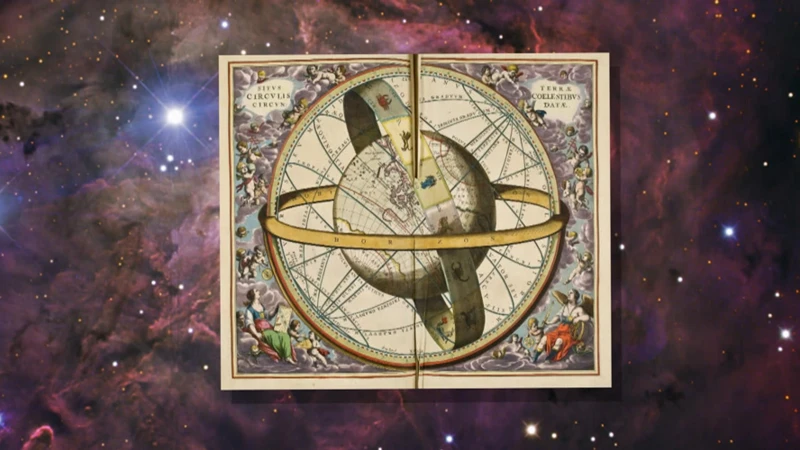
Unveiling the Astronomical Ophiuchus
When we turn our gaze to the astronomical perspective of Ophiuchus, we discover a captivating world of stars and celestial wonders. Ophiuchus is located near the celestial equator and is part of the zodiac belt, although it is not traditionally recognized as one of the twelve zodiac signs. The constellation can be prominently observed in both the Northern and Southern hemispheres, making it visible to a wide range of cultures across the globe.

|
|
The alignment of Ophiuchus with other constellations and its unique location within the zodiac belt further contribute to its astronomical significance. The celestial beauty and associations tied to Ophiuchus have fascinated astronomers and stargazers for centuries, inspiring a deep appreciation for the wonders of the universe. As we continue to explore Ophiuchus in all its glory, we will uncover its influence on astrology, spirituality, and the intriguing debates surrounding this enigmatic constellation.
Ophiuchus in Stellar Cartography
Ophiuchus, not only holds significance in mythology and astrology but also plays a vital role in stellar cartography. Stellar cartography is the practice of mapping and studying celestial objects, including stars and constellations. In this field, Ophiuchus is recognized as one of the 88 official constellations and is situated near the celestial equator. It lies between the constellations of Serpens and Scorpius, making it an important reference point for astronomers and navigators alike. Ophiuchus is particularly notable for its inclusion of several bright stars, including Rasalhague (Alpha Ophiuchi) and Cebalrai (Beta Ophiuchi), which add to its visual splendor. These stars, along with others in the constellation, have been meticulously recorded and cataloged over the years to aid in astronomical research and exploration. The exact positioning and intricate details of Ophiuchus in stellar cartography serve as a valuable scientific resource, contributing to our understanding of the vast and awe-inspiring universe we inhabit.
Artists and astronomers have captured the celestial allure of Ophiuchus through stunning visual representations. These depictions not only showcase the constellation’s unique shape and star patterns but also reflect its mythical and astrological significance. Stellar cartography offers us a window into the celestial heavens, allowing us to appreciate the ever-evolving understanding of Ophiuchus and its place among the countless wonders of the universe. Its prominent presence in stellar cartography cements Ophiuchus as a celestial beacon, guiding our exploration and fascination with the vastness of space.
The Alignment with the Ophiuchus Constellation
The alignment with the Ophiuchus constellation is a fascinating aspect of its historical significance. Ophiuchus is located near the celestial equator, making it visible in both the northern and southern hemispheres. The constellation is characterized by a distinct shape resembling a man holding a serpent. Its brightest star, Rasalhague, shines prominently in the night sky.
Compared to the traditional zodiac constellations, Ophiuchus takes up a significant portion of space. In fact, it lies between Scorpius and Sagittarius, and astrologically, Ophiuchus overlaps with parts of the signs Sagittarius and Scorpio. This has led to discussions and debates about the inclusion of Ophiuchus as a thirteenth zodiac sign. However, it’s important to note that while Ophiuchus may have a significant presence in the celestial sphere, it is not officially recognized as a zodiac sign in Western astrology.
|
|
Ophiuchus and the Serpent
The alignment of the Ophiuchus constellation with this prominent celestial figure has not only captivated astronomers but also artists throughout history. Artists have depicted Ophiuchus in various forms, often highlighting the man’s interaction with the serpent. This symbolic representation emphasizes the duality inherent in Ophiuchus, representing the struggle between the opposing forces of life and death, healing and poison. |
Despite not being an official zodiac sign, the alignment of Ophiuchus with other constellations makes it an intriguing and significant presence in the night sky. Many stargazers and astrology enthusiasts have taken an interest in exploring the potential astrological influences associated with Ophiuchus, further adding to its historical and astronomical significance.
Conclusion
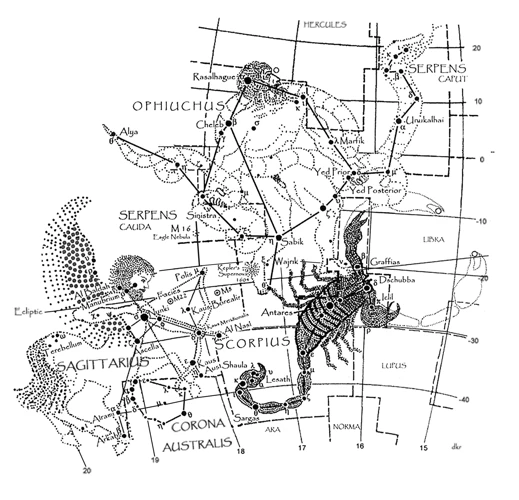
In conclusion, exploring the historical significance of Ophiuchus reveals a captivating journey through time. From its mythological roots in ancient Greece to its presence in various ancient civilizations around the world, Ophiuchus has consistently represented qualities of healing, knowledge, and creation. The celestial figure’s association with the art of medicine and its connection to the serpent and staff symbolism resonates even in modern times. Ophiuchus’ significance extends beyond mythology and astrology, as it has made its way into popular culture, inspiring artists and creatives to depict its image in various forms. Through the ages, Ophiuchus has sparked debates and controversies, challenging traditional views of the zodiac and prompting discussions about identity and astrology’s role in our lives. As we unveil the astronomical understanding of Ophiuchus and its alignment with the Ophiuchus constellation, we gain a deeper appreciation for its place in the vast cosmos. Whether you are curious about the spiritual aspects of Ophiuchus or interested in understanding the strengths and weaknesses associated with its personality traits, Ophiuchus continues to intrigue and fascinate. So, let us embrace this enigmatic celestial figure and explore the mysteries it holds within its celestial realm.
| Further Reading: |
Frequently Asked Questions
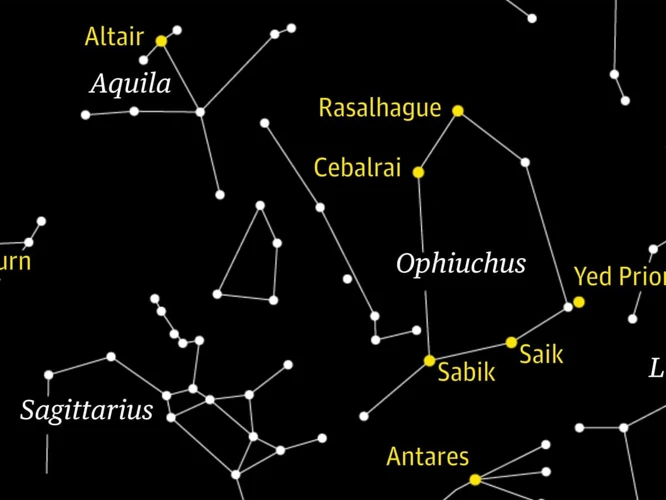
FAQs about Ophiuchus
1. Can Ophiuchus be considered the 13th zodiac sign?
While Ophiuchus is indeed a constellation, it is not officially recognized as a zodiac sign in Western astrology. The traditional zodiac system consists of 12 signs that correspond to specific periods of the year.
2. What are the dates for the Ophiuchus zodiac sign?
Since Ophiuchus is not a recognized zodiac sign, it does not have specific dates assigned to it. The zodiac calendar consists of the 12 signs, each with its own range of dates.
3. Does Ophiuchus have unique personality traits?
While Ophiuchus does not have official astrological personality traits, some enthusiasts believe that those born under this constellation exhibit characteristics associated with healing, wisdom, and creativity.
4. How does Ophiuchus affect the other zodiac signs?
In astrology, Ophiuchus is not directly associated with influencing other zodiac signs. However, its existence as a constellation provides additional depth and intrigue to the study of astrology.
5. Can I find Ophiuchus in the night sky?
Absolutely! Ophiuchus is a prominent constellation and can be observed in the night sky, particularly during certain times of the year. Its distinctive shape makes it easier to identify for stargazers.
6. Is there a connection between Ophiuchus and the medical profession?
Ophiuchus has long been associated with healing and medicine in various mythologies. This connection has carried through history, and today it serves as a symbol for the medical profession and its dedication to healing.
7. Are there any famous individuals associated with Ophiuchus?
While there are no public figures specifically associated with Ophiuchus, it’s important to note that the constellation represents a wider range of characteristics that can be found in individuals born under other zodiac signs.
8. Is Ophiuchus considered a positive or negative influence in astrology?
As with all astrological interpretations, the perception of Ophiuchus can vary depending on personal beliefs. Some may view its association with healing and wisdom as positive, while others may not place significance on the constellation.
9. Why is Ophiuchus not commonly mentioned in horoscopes?
Ophiuchus is not commonly mentioned in horoscopes due to its absence from the traditional zodiac system. However, with the growing interest in alternative perspectives, there has been increased attention on the constellation in recent years.
10. Can I incorporate Ophiuchus into my astrological readings?
If you’re interested in exploring Ophiuchus in your astrological readings, you can certainly incorporate it as a point of curiosity and further research. Remember to approach it with an open mind and consider its symbolism within your own interpretations.
References
Frequently Asked Questions

Can you explain the origins of the Ophiuchus constellation?
The Ophiuchus constellation has ancient origins, dating back to the Greeks, who believed it represented the god Apollo wrestling with a serpent, symbolizing the struggle between good and evil.
How is Ophiuchus connected to astrology?
Ophiuchus is often referred to as the 13th zodiac sign, representing those born between November 29 and December 17. However, it is not officially recognized in traditional Western astrology.
What are some historical interpretations of Ophiuchus?
In ancient Egypt, Ophiuchus was associated with the god Imhotep, who was revered as a healer and physician. In Chinese astrology, Ophiuchus corresponds to the Snake sign, known for being intuitive and analytical.
How did Arabic astrology influence the perception of Ophiuchus?
Arabic astrology played a significant role in shaping the perception of Ophiuchus. It associated the constellation with the mythical figure of Aesculapius, the god of medicine and healing.
What is the significance of Ophiuchus in medieval astrology?
In medieval astrology, Ophiuchus was seen as a potent symbol of healing and medicine. It was believed that those born under this sign possessed great knowledge and skill in the healing arts.
How has Ophiuchus been depicted in popular culture?
Ophiuchus has made appearances in various forms of media, including books, movies, and TV shows. It is often portrayed as a mysterious and enigmatic character with supernatural abilities.
What are some controversies surrounding Ophiuchus?
One controversial aspect of Ophiuchus is its status as the 13th zodiac sign. Some astrologers argue that it should be included in the traditional zodiac, while others dismiss its significance entirely.
What can we learn from the astronomical perspective of Ophiuchus?
From an astronomical perspective, Ophiuchus is a constellation located near the celestial equator. Its position allows astronomers to study star systems and celestial phenomena within its boundaries.
How does Ophiuchus feature in stellar cartography?
In stellar cartography, Ophiuchus is an essential constellation. It helps astronomers map the positions and movements of stars and galaxies, contributing to our understanding of the universe.
What does the alignment with the Ophiuchus constellation signify?
The alignment with the Ophiuchus constellation signifies an area of the sky that contains numerous celestial objects, including star clusters, nebulae, and galaxies. It provides astronomers with fascinating subjects of study.




